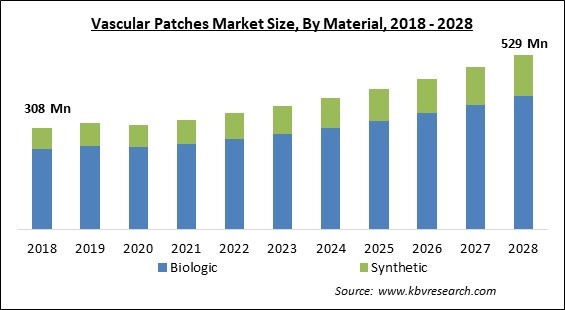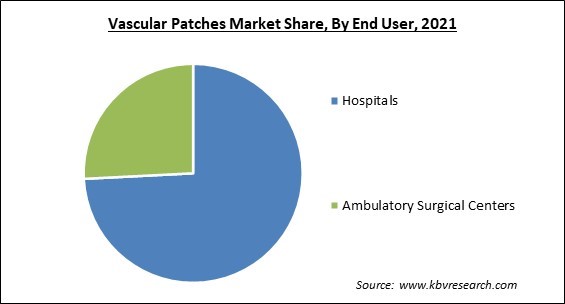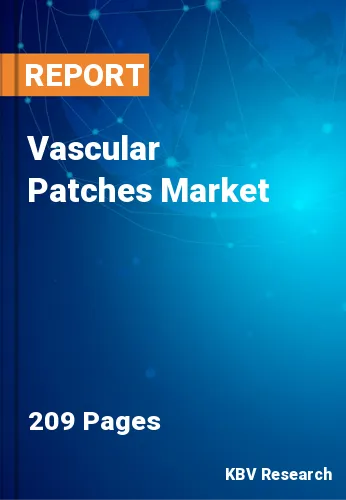The Global Vascular Patches Market size is expected to reach $529 Million by 2028, rising at a market growth of 7.1% CAGR during the forecast period.
Vascular patches are microporous polyester-urethane patches used in vascular procedures to close the wound with sutures. The World Health Organization (WHO) reports that cardiovascular diseases—which take 17.9 million lives annually—are the main cause of death. Vascular patches have great tissue integration, are highly biocompatible, have low infectious potential, low suture line bleeding, don't require impregnation or pre-clotting, and have good handling characteristics.

Due to the growing frequency of cardiac difficulties, technological advancements, and improvements in healthcare, the global market for vascular patches is anticipated to develop profitably in the years to come. A recent cross-disciplinary area of medical study is vascular surgery. Vascular surgeries are classed in that a range of artificial grafts (stents, stent-grafts, artificial blood vessels) are commonly used in clinical disciplines.
Vascular surgeries have many features with other clinical disciplines. Although most vascular surgical procedures are clean, the likelihood of infection is typically substantial since artificial grafts are frequently used. Additionally, patients undergoing vascular surgery are frequently elderly and are more likely to have a number of internal medical conditions, including diabetes, weak immune systems, immunological disorders, hypertension, and heart disease.
After pancreas or kidney transplantation, infectious vascular problems can put the recipient's life and limb, as well as the donated organ, in danger. These serious disorders can call for intricate vascular repair and vascular excision. The prevalence of vascular disorders is rising, the geriatric population is expanding quickly, biological patches are being more widely used, and there are more vascular surgeries being conducted, all of which are factors that are propelling the worldwide vascular patches market.
Patients delaying hospital exposure and diverting resources to urgent care have had a significant impact on the health of patients undergoing vascular surgery, in addition to COVID-19-related aftereffects. Despite no regional variation in the application of COVID-19 operating room rules, accessibility to personal protective equipment (PPE), or compliance with national surgical standards, many surgeries were either canceled or postponed electively. Vascular surgery services and patient access have been severely limited as a result of the pandemic. Vascular care is being delivered in a very different way. Many vascular surgeons who practice in outpatient clinics and ambulatory care reported that their practice has altered, including the use of telemedicine services and shorter hours. The impact on inpatient services was likewise significant.
One of the main causes of the rising occurrence of various diseases and ailments, including CVDs, hypertension, high cholesterol, strokes, cancer, and aneurysms, is the rapidly expanding senior population worldwide. The aging population is a key predictor of market growth because it is thought that aging is a major factor in the decline of cardiac health. By 2030, one in every six people worldwide will be 60 years of age or older, predicts the WHO.
Vascular surgeons support other surgical specialties during operations in a crucial way. The frequency and financial worth of this operational support, which has a large contribution margin and contribution margin ratio, are substantial. Vascular surgeons, in their function as consulting surgeons, facilitate the resolution of extremely complex cases and, in doing so, add significantly to the hospital's financial value. The primary characteristic of patients is multi-morbidity. It denotes the concurrent presence of two or more chronic diseases.
Vascular patches must be handled by skilled personnel since poor artery closure following surgery can result in ongoing bleeding or ischemia. While using some gadgets, many actions must be taken in order. One of the main barriers preventing the widespread use of these goods at the moment is the shortage of surgeons in both industrialized and emerging nations. For instance, the US is expected to experience a 122,000 physician deficit by 2032, according to the Association of American Medical Colleges (AAMC).
Based on material, the market is classified into biologic and synthetic. The biologic vascular patch segment held the largest market share for vascular patches in 2021, mainly because it was easier to apply, had a lower risk of infection after surgery, and had greater biocompatibility. The biologic vascular patches' biodegradable quality and greater tensile and suture retention strength are two of their key advantages.

Based on Applications, the market was categorized into Carotid Endarterectomy, Open Repair of Abdominal Aneurysm, Vascular Bypass Surgery, Congenital Heart Diseases, and Others. During 2021, carotid endarterectomy gained the largest revenue share in the market. In order to relieve this narrowing and so lower the risk of stroke, a procedure known as a carotid endarterectomy requires opening the carotid artery. The risk of strokes is decreased by placing a patch into the opening in the artery as the artery is closed at the end of the procedure.
Based on the End-user, the market is categorized into Hospitals and Ambulatory Surgical Centers. Ambulatory surgery centers are anticipated to experience the fastest growth during the forecasted timeframe. According to the ambulatory surgical center association, ambulatory surgery centers (ASCs) are a brand-new type of healthcare institution designed to provide same-day surgical treatment, including diagnostic and preventative procedures.
| Report Attribute | Details |
|---|---|
| Market size value in 2021 | USD 331.8 Million |
| Market size forecast in 2028 | USD 529 Million |
| Base Year | 2021 |
| Historical Period | 2018 to 2020 |
| Forecast Period | 2022 to 2028 |
| Revenue Growth Rate | CAGR of 7.1% from 2022 to 2028 |
| Number of Pages | 209 |
| Number of Tables | 350 |
| Report coverage | Market Trends, Revenue Estimation and Forecast, Segmentation Analysis, Regional and Country Breakdown, Companies Strategic Developments, Company Profiling |
| Segments covered | Material, End User, Application, Region |
| Country scope | US, Canada, Mexico, Germany, UK, France, Russia, Spain, Italy, China, Japan, India, South Korea, Singapore, Malaysia, Brazil, Argentina, UAE, Saudi Arabia, South Africa, Nigeria |
| Growth Drivers |
|
| Restraints |
|
Based on geography, the market is classified into North America, Europe, Asia Pacific, and LAMEA. Due to the rising elderly population and the high prevalence of cardiovascular illnesses in the region, North America is predicted to have a leading position in the global market for vascular patches. For instance, a March 2015 article from the US Census Bureau states that the country's elderly population is projected to rise from 319 million in 2014 to more than 400 million in 2060, hitting 400 million in 2051.
Free Valuable Insights: Global Vascular Patches Market size to reach USD 529 Million by 2028
The market research report covers the analysis of key stake holders of the market. Key companies profiled in the report include Edwards Lifesciences Corporation, Baxter International, Inc., Lemaitre Vascular, Inc., Becton, Dickinson and Company, Terumo Corporation, Aziyo Biologics, Inc., Getinge AB, B. Braun Melsungen AG, Artivion, Inc. (CryoLife, Inc.), and W. L. Gore & Associates, Inc.
By Material
By End User
By Application
By Geography
The global Vascular Patches Market size is expected to reach $529 Million by 2028.
Increasing Geriatric Population And Rising Vascular Disease Prevalence are driving the market in coming years, however, Growing requirement for qualified personnel restraints the growth of the market.
Edwards Lifesciences Corporation, Baxter International, Inc., Lemaitre Vascular, Inc., Becton, Dickinson and Company, Terumo Corporation, Aziyo Biologics, Inc., Getinge AB, B. Braun Melsungen AG, Artivion, Inc. (CryoLife, Inc.), and W. L. Gore & Associates, Inc.
The expected CAGR of the Vascular Patches Market is 7.1% from 2022 to 2028.
The Hospitals segment acquired maximum revenue share in the Global Vascular Patches Market by End User in 2021 thereby, achieving a market value of $377 Million by 2028.
The North America market dominated the Global Vascular Patches Market by Region in 2021, and would continue to be a dominant market till 2028; thereby, achieving a market value of $197.4 Million by 2028.
Our team of dedicated experts can provide you with attractive expansion opportunities for your business.

